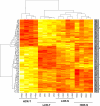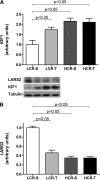Gene expression profiling of skeletal muscle in exercise-trained and sedentary rats with inborn high and low VO2max
- PMID: 18780757
- PMCID: PMC2585023
- DOI: 10.1152/physiolgenomics.90282.2008
Gene expression profiling of skeletal muscle in exercise-trained and sedentary rats with inborn high and low VO2max
Abstract
The relationship between inborn maximal oxygen uptake (VO(2max)) and skeletal muscle gene expression is unknown. Since low VO(2max) is a strong predictor of cardiovascular mortality, genes related to low VO(2max) might also be involved in cardiovascular disease. To establish the relationship between inborn VO(2max) and gene expression, we performed microarray analysis of the soleus muscle of rats artificially selected for high- and low running capacity (HCR and LCR, respectively). In LCR, a low VO(2max) was accompanied by aggregation of cardiovascular risk factors similar to the metabolic syndrome. Although sedentary HCR were able to maintain a 120% higher running speed at VO(2max) than sedentary LCR, only three transcripts were differentially expressed (FDR <or=0.05) between the groups. Sedentary LCR expressed high levels of a transcript with strong homology to human leucyl-transfer RNA synthetase, of whose overexpression has been associated with a mutation linked to mitochondrial dysfunction. Moreover, we studied exercise-induced alterations in soleus gene expression, since accumulating evidence indicates that long-term endurance training has beneficial effects on the metabolic syndrome. In terms of gene expression, the response to exercise training was more pronounced in HCR than LCR. HCR upregulated several genes associated with lipid metabolism and fatty acid elongation, whereas LCR upregulated only one transcript after exercise training. The results indicate only minor differences in soleus muscle gene expression between sedentary HCR and LCR. However, the inborn level of fitness seems to influence the transcriptional adaption to exercise, as more genes were upregulated after exercise training in HCR than LCR.
Figures




Comment in
-
Unraveling the molecular underpinning of nature and nurture of aerobic fitness.Physiol Genomics. 2008 Nov 12;35(3):210-2. doi: 10.1152/physiolgenomics.90349.2008. Epub 2008 Oct 14. Physiol Genomics. 2008. PMID: 18854369 No abstract available.
Similar articles
-
Aerobic capacity-dependent differences in cardiac gene expression.Physiol Genomics. 2008 Mar 14;33(1):100-9. doi: 10.1152/physiolgenomics.00269.2007. Epub 2008 Jan 2. Physiol Genomics. 2008. PMID: 18171719
-
Skeletal muscle metabolism in rats with low and high intrinsic aerobic capacity: Effect of aging and exercise training.PLoS One. 2018 Dec 11;13(12):e0208703. doi: 10.1371/journal.pone.0208703. eCollection 2018. PLoS One. 2018. PMID: 30533031 Free PMC article.
-
Continued artificial selection for running endurance in rats is associated with improved lung function.J Appl Physiol (1985). 2009 Jun;106(6):1810-8. doi: 10.1152/japplphysiol.90419.2008. Epub 2009 Mar 19. J Appl Physiol (1985). 2009. PMID: 19299574 Free PMC article.
-
Systemic oxygen transport in rats artificially selected for running endurance.Respir Physiol Neurobiol. 2006 Apr 28;151(2-3):141-50. doi: 10.1016/j.resp.2005.09.012. Epub 2005 Dec 15. Respir Physiol Neurobiol. 2006. PMID: 16344008 Review.
-
Kenyan dominance in distance running.Comp Biochem Physiol A Mol Integr Physiol. 2003 Sep;136(1):161-70. doi: 10.1016/s1095-6433(03)00227-7. Comp Biochem Physiol A Mol Integr Physiol. 2003. PMID: 14527638 Review.
Cited by
-
Brain activation patterns at exhaustion in rats that differ in inherent exercise capacity.PLoS One. 2012;7(9):e45415. doi: 10.1371/journal.pone.0045415. Epub 2012 Sep 17. PLoS One. 2012. PMID: 23028992 Free PMC article.
-
Adaptive Modifications of Muscle Phenotype in High-Altitude Deer Mice Are Associated with Evolved Changes in Gene Regulation.Mol Biol Evol. 2015 Aug;32(8):1962-76. doi: 10.1093/molbev/msv076. Epub 2015 Apr 7. Mol Biol Evol. 2015. PMID: 25851956 Free PMC article.
-
Genetically determined exercise capacity affects systemic glucose response to insulin in rats.Physiol Genomics. 2021 Sep 1;53(9):395-405. doi: 10.1152/physiolgenomics.00014.2021. Epub 2021 Jul 23. Physiol Genomics. 2021. PMID: 34297615 Free PMC article.
-
Usefulness of cardiorespiratory fitness to predict coronary heart disease risk independent of physical activity.Am J Cardiol. 2010 Jul 15;106(2):210-5. doi: 10.1016/j.amjcard.2010.03.017. Epub 2010 Jun 10. Am J Cardiol. 2010. PMID: 20599005 Free PMC article.
-
Adult Hippocampal Neurogenesis and Affective Disorders: New Neurons for Psychic Well-Being.Front Neurosci. 2021 Jun 16;15:594448. doi: 10.3389/fnins.2021.594448. eCollection 2021. Front Neurosci. 2021. PMID: 34220412 Free PMC article. Review.
References
-
- Bengtsson J, Gustafsson T, Widegren U, Jansson E, Sundberg CJ. Mitochondrial transcription factor A and respiratory complex IV increase in response to exercise training in humans. Pflügers Arch 443: 61–66, 2001. - PubMed
-
- Benjamini Y, Hochberg Y. Controlling the false discovery rate - a practical and powerful approach to multiple testing. J Royal Statistical Society Series B: 289–300, 1995.
-
- Bye A, Langaas M, Høydal MA, Kemi OJ, Heinrich G, Koch LG, Britton SL, Najjar SM, Ellingsen Ø, Wisløff U. Aerobic capacity-dependent differences in cardiac gene expression. Physiol Genomics 33: 100–109, 2008. - PubMed
-
- Chomyn A, Enriquez JA, Micol V, Fernandez-Silva P, Attardi G. The mitochondrial myopathy, encephalopathy, lactic acidosis, and stroke-like episode syndrome-associated human mitochondrial tRNALeu(UUR) mutation causes aminoacylation deficiency and concomitant reduced association of mRNA with ribosomes. J Biol Chem 275: 19198–19209, 2000. - PubMed
Publication types
MeSH terms
Substances
Grants and funding
LinkOut - more resources
Full Text Sources
Molecular Biology Databases

